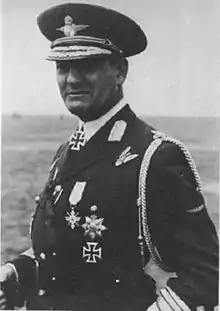Emanoil Ionescu
Emanoil Ionescu (17 March 1887 – 14 June 1949) was a Romanian General during World War II and commander of the Romanian Air Force's Corpul I Aerian.
Emanoil Ionescu | |
|---|---|
 Emanoil Ionescu on May 10, 1944 | |
| Born | 17 March 1887 Tămpeni, Olt County, Kingdom of Romania |
| Died | 14 June 1949 (aged 62) Bucharest, Romanian People's Republic |
| Allegiance | |
| Service/ | Air Force |
| Years of service | 1911 – 1948 |
| Rank | Squadron general |
| Commands held | 1st Air Corps |
| Battles/wars | World War II Hungarian–Romanian War World War II |
| Awards | Knight's Cross of the Iron Cross Order of Michael the Brave Order of Suvorov |
| Alma mater | Higher War School |
Biography
He was born in 1887 in Tămpeni, now Movileni, Olt County. After attending the Military School for Officers, he graduated with the rank of second lieutenant in 1911. During World War I he served in the 43rd Infantry Regiment. He enrolled as a volunteer at the Aviation School in Botoșani and obtained his pilot's license on July 11, 1918, after which he was assigned to the 4th Aviation Group. In the spring of 1919, when the Hungarian communist army attacked Romania, lieutenant Ionescu asked to be assigned to the 5th Aviation Group in Sibiu, an air subunit made available to General Gheorghe Mărdărescu, commander of the Romanian forces in Transylvania during the Hungarian–Romanian War. In April-June 1919 he carried out several combat missions aboard Sopwith 1½ Strutter aircraft, gathering information and bombing enemy targets.[1]
Ionescu was promoted to captain in April 1920, and appointed squadron commander; the following year he was promoted to major, and given the command of an air group. From 1925 to 1937 he flew intensely and became known to the public after the "Raid of Greater Romania" (3,700 km in 11 hours, with a stopover), done with Traian Burduloiu in 1927. From 1927 to 1929 he attended the Higher War School. In April 1937, he took command of the 3rd Fighter Wing, based in Galați, with the rank of captain-commander; half a year later, he was promoted to commander.[1] Between 1938 and 1939, Ionescu held the position of professor at the Higher War School and commander of the "Aurel Vlaicu" Military Aviation School in Bucharest. He was promoted to the rank of squadron general on May 10, 1941.
After Romania entered World War II on the side of the Axis on June 22, 1941, Ionescu commanded the air unit assigned to the Romanian 4th Army, and flew 40 hours in support of the crossings of rivers Prut and Dniester by the 4th Army. In September 1943 he became commander of the 1st Air Corps, the only large Romanian air unit on the Eastern Front. After King Michael's Coup of August 23, 1944, when Romania switched sides to the Allies, Ionescu continued to command the Royal Romanian Air Force on the front lines in Transylvania, Hungary, and Czechoslovakia, providing air support to the Romanian 1st and 4th Armies. On March 10, 1945 he handed over the command to Air Squadron General Traian Burduloiu and returned to Bucharest, where he had been appointed Undersecretary of State for the Air Force.[1]
He entered the reserve on January 1, 1948. A year and a half later, he died in Bucharest.[1]
In 2002, the RoAF 71st Air Base at Câmpia Turzii and the Fighter Wing based there were named in his honor.[1][2] A street in Slatina is also named in Ionescu's memory.
Awards
- Iron Cross (1939) 2nd and 1st Class
- Knight's Cross of the Iron Cross on 10 May 1944 as General de escadră and commanding general of the Royal Romanian 1st Air Corps[3][4]
- Order of Michael the Brave 3rd Class (4 August 1945)[5]
- Order of Suvorov 1st Class (9 August 1945)[6]
References
- "General Emanoil Ionescu". roaf.ro (in Romanian). Romanian Air Force. Retrieved October 22, 2020.
- "Baza 71 Aeriană "General Emanoil Ionescu" Câmpia Turzii". cliffibell.co.uk. Retrieved October 22, 2020.
- Fellgiebel, Walther-Peer (2000) [1986]. Die Träger des Ritterkreuzes des Eisernen Kreuzes 1939–1945 — Die Inhaber der höchsten Auszeichnung des Zweiten Weltkrieges aller Wehrmachtteile [The Bearers of the Knight's Cross of the Iron Cross 1939–1945 — The Owners of the Highest Award of the Second World War of all Wehrmacht Branches] (in German). Friedberg, Germany: Podzun-Pallas. p. 462. ISBN 978-3-7909-0284-6.
- Scherzer, Veit (2007). Die Ritterkreuzträger 1939–1945 Die Inhaber des Ritterkreuzes des Eisernen Kreuzes 1939 von Heer, Luftwaffe, Kriegsmarine, Waffen-SS, Volkssturm sowie mit Deutschland verbündeter Streitkräfte nach den Unterlagen des Bundesarchives [The Knight's Cross Bearers 1939–1945 The Holders of the Knight's Cross of the Iron Cross 1939 by Army, Air Force, Navy, Waffen-SS, Volkssturm and Allied Forces with Germany According to the Documents of the Federal Archives] (in German). Jena, Germany: Scherzers Miltaer-Verlag. p. 413. ISBN 978-3-938845-17-2. (According to Scherzer on 28 April 1944)
- Decretul Regal nr. 1.935 din 1 iulie 1942 pentru conferiri de decorațiuni și războiu ofițerilor și trupei din armata germană și română, publicat în Monitorul Oficial, anul CX, nr. 161 din 14 iulie 1942, partea I-a, p. 5.825.
- "Ukase of the USSR" (in Russian). Moscow. August 9, 1945. Retrieved October 23, 2020.